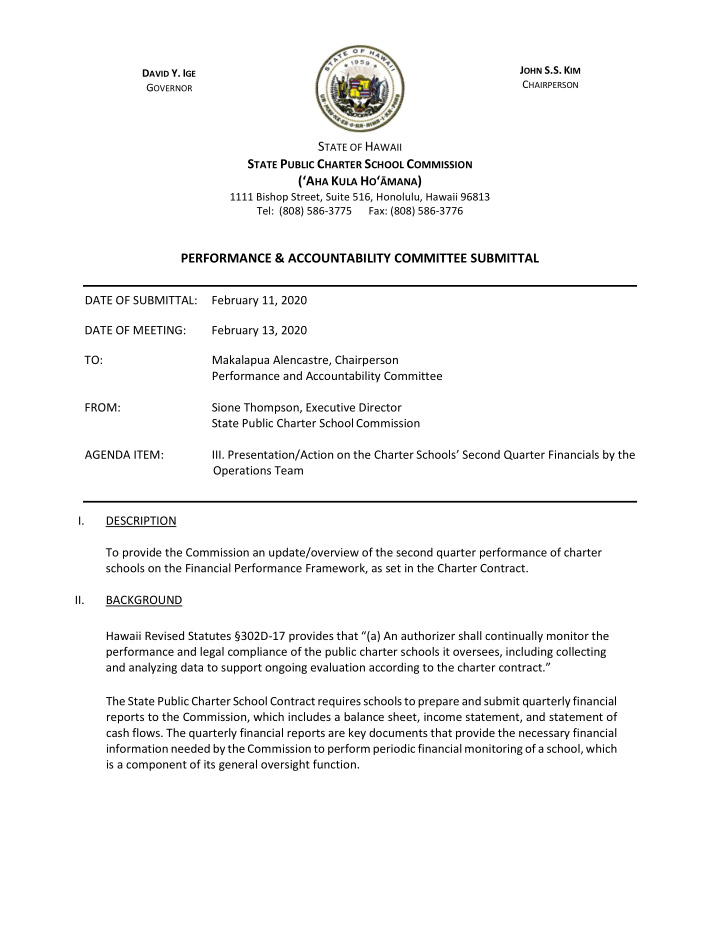



J OHN S.S. K IM D AVID Y. I GE C HAIRPERSON G OVERNOR S TATE OF H AWAII S TATE P UBLIC C HARTER S CHOOL C OMMISSION (ʻA HA K ULA H O ʻ ĀMANA ) 1111 Bishop Street, Suite 516, Honolulu, Hawaii 96813 Tel: (808) 586-3775 Fax: (808) 586-3776 PERFORMANCE & ACCOUNTABILITY COMMITTEE SUBMITTAL DATE OF SUBMITTAL: February 11, 2020 DATE OF MEETING: February 13, 2020 TO: Makalapua Alencastre, Chairperson Performance and Accountability Committee FROM: Sione Thompson, Executive Director State Public Charter School Commission AGENDA ITEM: III. Presentation/Action on the Charter Schools’ Second Quarter Financials by the Operations Team I. DESCRIPTION To provide the Commission an update/overview of the second quarter performance of charter schools on the Financial Performance Framework, as set in the Charter Contract. II. BACKGROUND Hawaii Revised Statutes §302D-17 provides that “(a) An authorizer shall continually monitor the performance and legal compliance of the public charter schools it oversees, including collecting and analyzing data to support ongoing evaluation according to the charter contract.” The State Public Charter School Contract requires schools to prepare and submit quarterly financial reports to the Commission, which includes a balance sheet, income statement, and statement of cash flows. The quarterly financial reports are key documents that provide the necessary financial information needed by the Commission to perform periodic financial monitoring of a school, which is a component of its general oversight function.
III. PRESENTATION Commission staff has reviewed and analyzed the second quarter financial reports submitted by all 37 schools in the Commission’s portfolio. These reports were submitted to Epicenter, the compliance management system administered by the Commission. Quarterly financial reports are due approximately 30 days after the close on each quarter; second quarter financials were due on January 31 st . By December of each year, charter schools receive two per pupil distributions which account for ninety percent of their state funding. This funding structure results in charter schools being “cash heavy” for much of the first and second quarters of their fiscal year. While this funding structure does allow for operational flexibility, it does limit the ability of both the Commission and the charter school governing board to determine any potential fiscal solvency issues early in the fiscal year. Second Quarter Risk Assessment Report for Fiscal Year 2019-2020 As of December 31, 2019, all 37 charter schools in the portfolio are categorized in either the “Low” or “Acceptable” risk designation according to Fiscal Year 2019-2020 Second Quarter Risk Assessment analysis under the Financial Performance Framework. Exhibit 1 of this submittal provides the work sheet used to provide the risk assessment results. As a point to note, Commission staff may be doing follow-up analysis of the financial reports and engaging in discussions with five charter schools which reported negative net assets at the end of the second quarter. To clarify, these five schools still received low or acceptable risk designations; however, as discussed above, the funding structure which provides the bulk of funding in the first two quarters can make it challenging to determine any potential fiscal issues. 2
Exhibit 1 Financial Performance Framework Audited Fiscal Year 2018-2019 Risk Assessment
Recommend
More recommend